This year’s recommendations review books and pamphlets that champion noble aspects of the past. Some of these publications long for a revival—or at least a recognition—of folkish activities, and others simply embrace pre-computer production methods.
To
see all the Wonderella recommendations, currently an annual
feature of this website, please follow the links here:
2002: The Best of the
Independent Press
2003: Summer Reads
2004:
Mystical England
2006: The Old Ways Are Best
Click
on the cover images for a closer look.

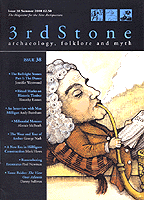
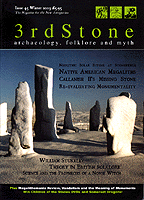
3rd Stone: Until wrapping up its 47-issue run in 2003, 3rd Stone offered lively, well-researched articles on the past, present, and future of the megalithic sites of Europe, with a particular focus on those in Britain. The series’ production value and illustration were equally impressive.
Since then, 3rd Stone editor Neil Mortimer has published two volumes reprinting the Avebury- and Stonehenge-related pamphlets of 18th-century antiquarian William Stukeley.
While we haven’t seen examples of early issues in this series, we do know that later numbers were printed at A4 size, or 11.75 x 8.25 inches and contain about 80 pages each. For prices and availability of back issues, check the series’ website or contact:
Neil Mortimer
P.O. Box 961
Devizes, Wiltshire SN10 2TS
England

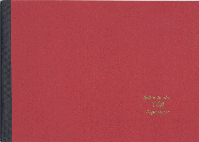
The Cunningham Amendment:
This perennial favorite of ours offers a consistent kick in the pants to people trampled by modern life and the bureaucracies that pretend to control our happiness. Each gorgeously letterpress printed issue of the TCA contains page after page of humorous, biting observations on the ways we are duped into giving up individual freedoms.
The most recent issue of the Cunningham Amendment is pictured above, and has 28 pages. Click the image for a closer look at the cover and a peek at the interior. The TCA measures 6.25 x 9 inches. A modest amount of cash and a nice letter will probably secure you a copy of the next issue. Inquire to:
The Cunningham Amendment
1005 Huddersfield Road
Bradford BD12 8LP
West Yorkshire, England

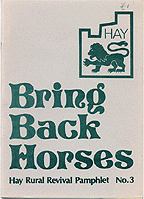
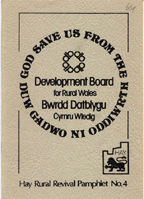
Hay Rural Revival Pamphlets: In 1977, Welsh bookshop entrepreneur Richard Booth declared himself “King Richard the Book-Hearted,” self-styled ruler of Hay-on-Wye and champion for the revitalization of the town’s past through a return to reliance on local business. As king, Booth disseminated his reform theories via pamphlets, two of which we acquired during our recent visit to one of Booth’s bookshops (housed in an honest-to-god crumbling castle).
In “Bring Back Horses,” Booth presents the case for the restoration of a horse-based economy to counter the industrialization and superfluous bureaucracy that has cost Hay and other Welsh towns countless jobs and doomed independent businesses and local crafts and services. The Amish community in Lancaster, Penn., is held up as a model for such a system.
“God Save Us from the Development Board for Rural Wales” investigates the phenomenon of the proliferation of DBRW factories in Hay and throughout the country. Booth visits several such factories and finds that those which haven’t failed after a few years are either on the brink of financial collapse or operating as importing facilities for foreign goods.
Other titles in the series, unavailable at the shop during our visit, include “Home Rule for Hay: The First Two Years” and “Abolish the Wales Tourist Board.”
The Rural Revival series is printed A5 size, or 8.25 x 5.5 inches. “Bring Back Horses” has 12 pages and “God Save Us from the Development Board for Rural Wales” has 24 pages. For information, contact Richard Booth via email or write to:
Hay Castle
Hay-on-Wye
Via Hereford HR3 5DL
Great Britain

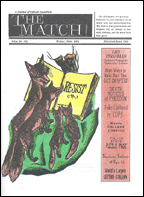
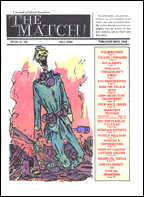
The Match!: The Match is the peerless American journal of ethical anarchism, a brand of anti-establishmentism that stops short of violence without losing any of the bile. Issue after issue, publisher Fred Woodworth consistently lays the case against government and religion with his dark and bitter wit.
Regular features include reviews of other anarchist publications, an extensive letters column, and a round-up of news stories regarding police brutality in the United States and abroad. Now in its 37th year, The Match has recently added a “Thirty-Five Years Ago in The Match” column which, more than anything else, reminds readers that America has been going down the tubes for quite some time.
The Match is printed 6.75 x 9.5 inches. Recent issues have had 80 pages. Subscriptions are free, but a donation of $10 is recommended for four issues. Send cash only, no checks, to:
The Match!
Post Office Box 3012
Tucson, Ariz. 85702

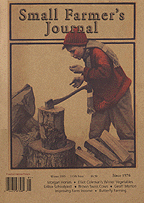
Small Farmer’s Journal: Not since the heydey of Mother Earth News has there been such a practical, anti-nostalgic publication for the current or would-be farmer. A quarterly, the Small Farmer’s Journal focuses on projects and issues for the horse-powered farm, but editor Lynn R. Miller applies an equal amount of horse sense to questions of politics and personal freedom. A topic in recent issues has been the pending National Animal Identification System (NAIS) legislation that would require farmers to implant microchips in each animal they own, right down to the last fish in the pond.
It’s refreshing to see a publication that expands ethical anarchism beyond theory and the individual and takes it into quite practical, community territory.
The Small Farmer’s Journal is printed tabloid size, or 10.75 x 13.5 inches. Issues run about 128 pages each. Subscriptions start at $35 for four issues, and back issues are available. Send checks to:
Small Farmer’s Journal
Post Office Box 1627
Sisters, Oreg. 97759

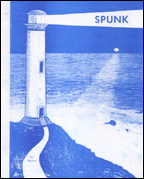
Spunk: Violet Jones shook up the underground press world a few years ago with the publication of The Free Press Death Ship. Although that milestone publication seems to have run aground after its third issue, the re-emergence of Violet’s long-running serial, Spunk, gives us hope that all is not lost.
Strictly speaking, Spunk could be identified as the premiere personal zine of ethical anarchism. This issue discusses some recent time-capsule buryings, reviews publications received, and even includes some sheet music penned by Jones and Sean Reinhart. Violet’s love of book arts shines through, too, with this issue offset printed and bound between pasteboard like an old-school notebook.
Despite how well-written and beautifully produced Spunk is, Violet lets us in on the burnout that accompanies the life of the underground artist in a touching editorial on the back cover. Fred Woodworth (editor of The Match!) began a column called “Situation Hopeless” years ago when he was convinced that there was nothing to be done about the corruption and ignorance ruining the world. Let’s hope Jones doesn’t throw in the towel, too.
Spunk is published occasionally in various shapes and sizes. The current issue measures 8.25 x 10.25 inches and has 40 pages. To get on (or stay on) the mailing list, send donations of cash, no checks, to:
Slow Burn Press
Post Office Box 55336
Hayward, Calif. 94545

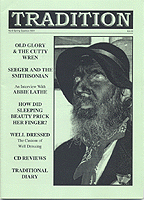
Tradition: Each number in this quarterly pamphlet series features a grab-bag of articles about how folk culture lives on in Britain, and is a terrific starting place for anyone interested in learning about the island’s traditional music, lore, or customs (such as the Morris Man pictured on the cover above). The handy calendar in Tradition’s back pages gives a preview of more than six months of upcoming festivals, concerts, and other events.
In 2004, Tradition averaged 28 pages per issue, and was printed A4 size, or 8.25 x 11.75 inches. More recent issues look as if they incorporate some color, to judge by the series’ website. Send all inquiries and correspondence to:
Tradition
9 Burwash
Witnesham
Ipswich, Suffolk
IP6 9EL
England

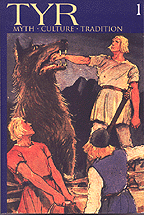
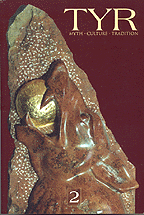
Tyr: With two issues in print to date, this journal serves as a manifesto and resource guide for the Radical Traditionalism movement. Simply stated, Tyr reject materialism and its devastating effects on spirituality, community, the individual, and the earth. Editors Joshua Buckley, Collin Cleary, and Michael Moynihan keep matters fairly lofty with philosophical articles on pre-Roman European myth and culture, but astute readers will probably be able to incorporate Tyr’s theories into everyday living. The second issue includes a 17-track anthology compact disc with a diverse selection of folk and experimental music (along the lines of what’s to be found on Ptolemaic Terrascope compilations).
Tyr measures 6 x 9 inches, the initial volume containing 286 pages (cover price $16), the second volume 430 (cover price $22). For current price and availability information, contact:
Ultra
Post Office Box 11736
Atlanta, Ga. 30355

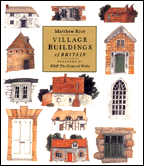
Village Buildings of Britain: This beautiful book is author and watercolorist Matthew Rice’s love letter to the local building styles and materials throughout Britain and a pattern book for caretakers and restorers of barns, churches, cottages, and other rural buildings. The book’s introduction alone is quite valuable for its maps of England, Scotland, and Wales, which divide the nation into geologic and vernacular regions. Rice’s strongly stated argument to maintain traditional architecture never resorts to mere nostalgia, but stresses the social and aesthetic benefits of traditional architecture.
Village Buildings of Britain has 160 satisfyingly thick pages and meaures 8.25 x 7 inches. For availability and pricing information, contact the artist at his website or by writing to:
Matthew Rice Ltd
Rhino House
Kestrel Way
Sowton Industrial Estate
Exeter
Devon
EX2 7LA